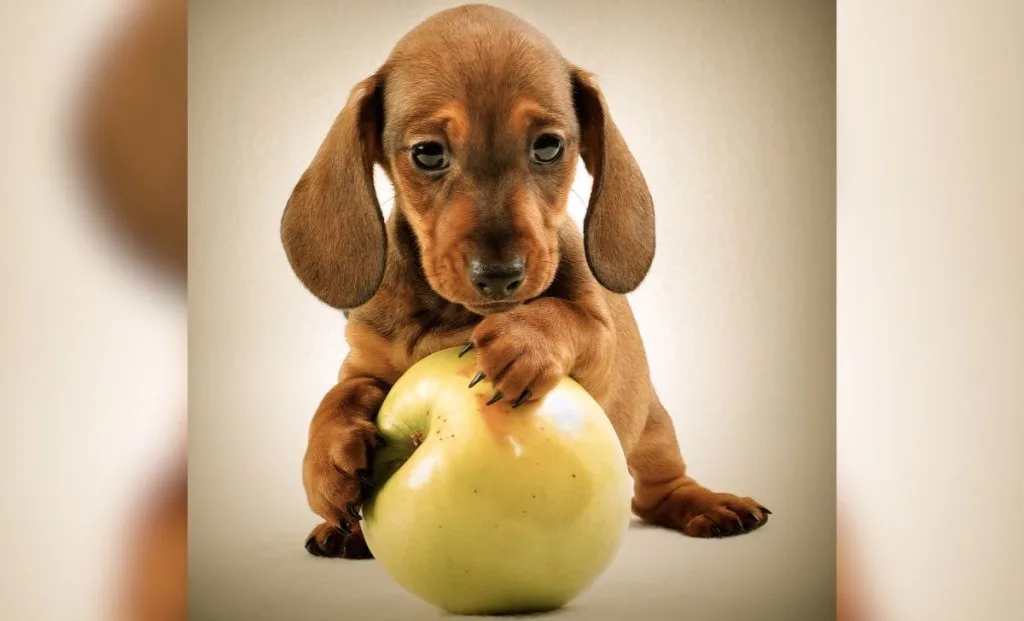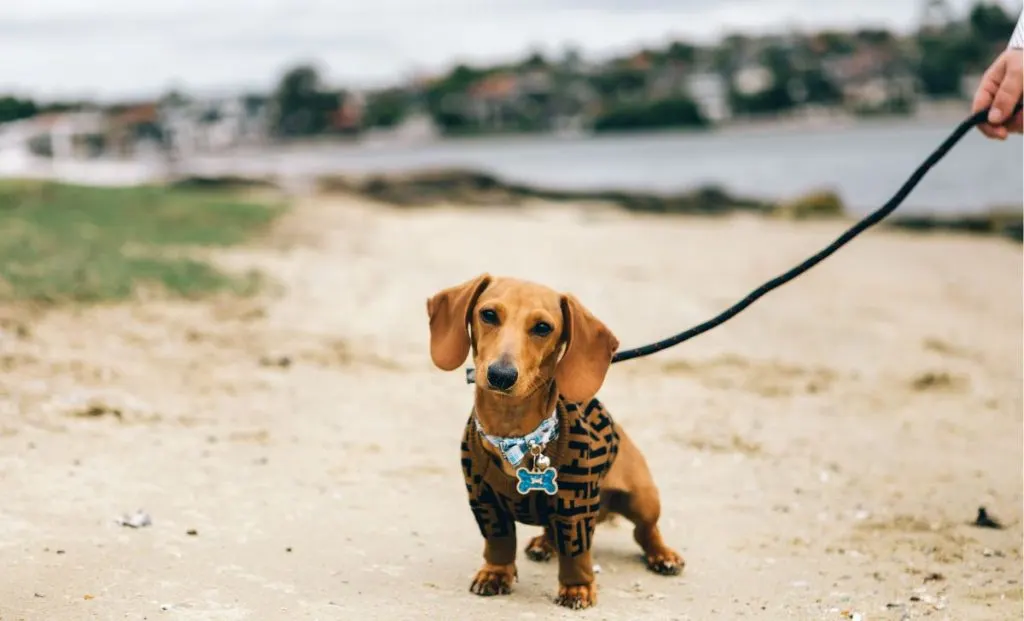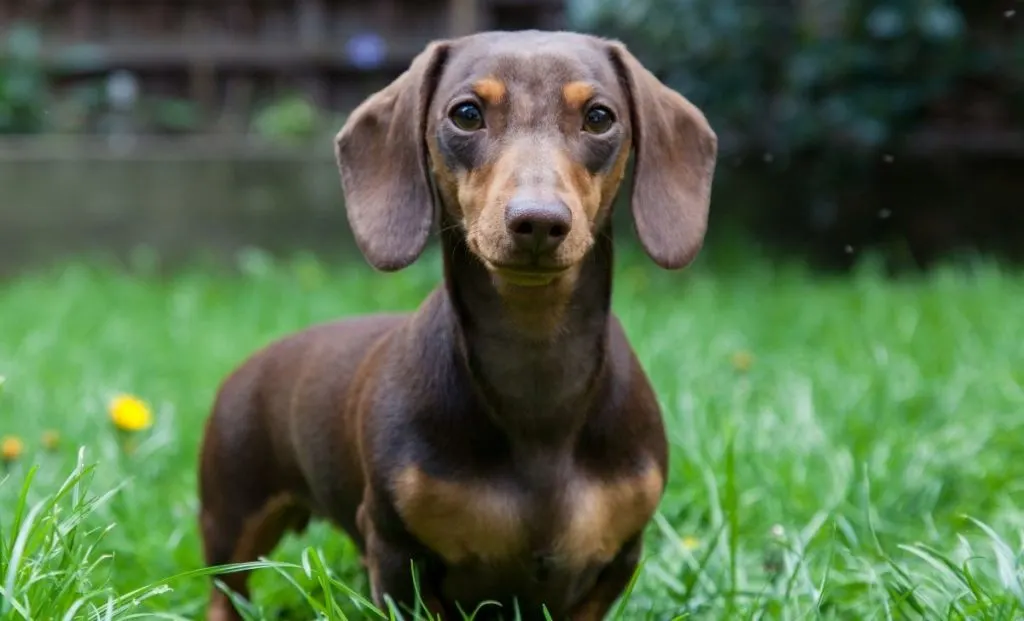Curious about adult height and weight charts of Mini Dachshunds? Well, you are at the right place. Let’s talk about Mini Dachshund growth stages! As charming as they are long, these pint-sized pups come with big personalities.
They may start small with their short legs and adorable pup proportions, but these Doxies eventually reach their full size.
How big will my Mini Dachshund get? Time to answer some questions!
Mini Dachshund Growth Stages Overview
From the tiniest of pups with their little eyes to the full height of adulthood, the growth stages of a Miniature Dachshund are full of adventures and nibbles.
To give you a good idea about the growth of these mini dogs, here is a quick overview:
| Growth Stage | Age Range | Description | Average Weight Range |
| Neonatal Stage | 0-2 weeks | Newborn puppies completely dependent on mother for warmth, nutrition, and care. | 3-5 ounces |
| Transitional Stage | 2-4 weeks | Puppies begin to open their eyes and ears, becoming more aware of their surroundings. | 8-12 ounces |
| Socialization Stage | 3-12 weeks | Critical period for learning social skills, exploring environment, and developing confidence. | 1-3 pounds |
| Juvenile Stage | 3-6 months | Rapid growth physically and mentally, transitioning from puppyhood to adolescence. | 4-8 pounds |
| Adolescent Stage | 6-12 months | Hormonal changes and maturation, testing boundaries, and exhibiting teenage-like behavior. | 8-12 pounds |
| Adulthood | 1 year and older | Reached full size and physical maturity, personality continues to develop into adulthood. | 11-16 pounds |
| Senior Years | 7 years and older | Golden years marked by a slower pace, potential health concerns, and a deep bond with pet owners. | 10-15 pounds (may vary widely) |
These puppy stages and weight ranges provide a rough guide of how much Mini Dachshunds typically weigh at each stage of their growth and development.
Keep in mind that individual sausage dogs may fall outside of these ranges based on factors like genetics, diet, and exercise.
7 Growth Stages Of A Miniature Dachshund
As petite pals with adorable short legs and tiny frames, Mini Dachshunds offer a charming twist on their larger counterparts. If we can label them as larger, that is…
Actually, Mini Doxies are not the miniest out there. In fact, the Kaninchen Dachshund is the smallest variant of this breed. But, our focus is on the mini version for now.
There are few different patterns within the Mini Dachshund growth, all of which are influenced by different factors (both environmental and genetic).
The best way to find out about these patterns and factors is to dive into the growth stages of these small dogs!
Neonatal Stage (0-2 Weeks)

During the first period of their life, the neonatal stage, mini Doxies are entirely reliant on their mother, just like all dogs are. Other small dogs with short legs, like Corgis, go through this phase, where the tiniest misstep can lead to challenges.
Mini Dachshund puppies are entirely reliant on their mother for survival. This stage is characterized by their delicate nature, with puppies spending the majority of their time nursing and sleeping.
While mom dogs are typically loving and nurturing, sometimes things can take a turn for the worse, as in the rare cases when mom dogs eat their puppies.
But, it is not all chaos. Amidst the trials and tribulations of puppyhood, there shines a beacon of hope: mother’s milk.
Colostrum is liquid gold, packed with much – needed antibodies that help Mini Dachshunds develop strong metabolisms and defend against health issues during their growth stages.
It’s vital for providing immunoglobulins and essential nutrients like lipids and carbohydrates, crucial for newborn survival, especially during the first two weeks of age (1).
These little furballs come into the world with minimal energy reserves and immature immune systems. So, they really need to ingest sufficient colostrum within the first few hours after birth!
Overall, the Neonatal Stage sets the tone for the Mini Dachshund’s growth journey.
Transitional Period (2 – 4 Weeks)
During this puppy stage, Mini Dachshund puppies begin to emerge from their cozy nests. Their teeny tiny legs are carrying them on new adventures around their environment.
Much like their counterparts in other small dog breeds such as Chihuahuas or Shih Tzus, Mini Dachshunds start to exhibit early signs of their unique personalities.
As they waddle through this puppy stage, Mini Doxies continue to rely on their mother for nourishment and guidance. They spend more time interacting with their littermates and the world around them.
Of course, this is when they start developing essential social skills and motor abilities.
Pet owners play an important role during this period. They provide a safe and stimulating environment for their Mini Doxies to thrive.
It is already a good idea to introduce them to gentle handling and slowly, but surely, build the foundation for future training and bonding experiences.
Socialization Stage (3 – 12 Weeks)

Oh look at these mini dogs go! Mini Doxie puppies are in their socialization phase, where they are learning to navigate the world around them with confidence and curiosity.
With motor abilities and scent both in perfect function, these pups are eagerly exploring their environment, encountering new sights, sounds, and smells at every turn.
This is the perfect stage for pet parents to introduce their Mini Dachshunds to a variety of new people and other animals. Think – various stimuli!
The best way to help a Mini Doxie grow mentally and physically is to expose them to different environments, surfaces, and situations. Trust me, this will help them become well-rounded and adaptable dogs in the long run.
As these puppies grow, dog owners may wonder, “How big is a Mini Dachshund at 12 weeks?”
At this period, these tiny pups typically have an average weight between 4 to 6 pounds on average and stand around 6 to 8 inches tall at the shoulder.
Pet owners often wonder about the best time to start training their Mini Dachshunds.
According to the American Kennel Club, early socialization and training during the puppy stage and transitional period lay the groundwork for success in adolescence and beyond.
However, it’s never too late to start training, and positive reinforcement techniques remain effective at any stage of life.
When Should My Mini Dachshund Be House Broken?
Housebreaking your Mini Dachshund is quite a milestone in their development, and the timing can vary from dog to dog.
Typically, Mini Dachshunds can begin the housebreaking process as early as 8 to 12 weeks of age. But, as with humans, each puppy develops at their own pace, so patience and consistency are key!
During the housebreaking process, it’s crucial to establish a routine and supervise your puppy closely, especially after meals, playtime, and naps.
Take them outside to their designated potty area frequently and praise them enthusiastically when they poop outdoors. It is all about linking positive feelings with a good habit. Hey, they might even kick after they poop, to show you how excited they are for the positive reinforcement!
Keep in mind that accidents are a natural part of the learning process, so be prepared for setbacks along the way.
If you see your Mini Doxie rolling in poop, avoid punishment! Instead focus on reinforcing desired behaviors.
With time, patience, and plenty of praise, your Mini Dachshund will learn to become reliably housebroken, making life easier for both you and your furry friend.
Juvenile Stage (3 – 6 Months)

At this stage, Mini Dachshund puppies continue to grow rapidly, both in size and in personality. Their short legs, a tiny bit longer now, carry them on playful adventures, while their boundless energy keeps dog owners on their toes.
That’s not all, these pups are now nibbling on their owners more than ever! But, they cannot help it, as their teeth are still growing.
And, how much should a 3 month old Mini Dachshund weigh? Well, pet owners often wonder about this specific milestone.
On average, a 3-month-old Mini Dachshund may weigh between 5 to 7 pounds, but individual variations are common.
Another common question among pet owners is ”Is a Dachshund fully grown at 6 months?”
While these pups may reach close to their adult size by 6 months, they are not typically considered fully grown yet!
It is true though, that they do not take as long to reach their adult weight and size as some other dog breeds, like the big Anatolian Shepherds do.
Health-wise, this puppy stage is crucial for monitoring their growth progress and making sure that they receive as much food as they need.
Quality puppy food tailored to their small size and nutritional needs is very important for supporting healthy development and preventing common health issues like excess weight and heart disease later in life.
However, puppy food will soon be replaced by adult formula.
Adolescent Stage (6 – 12 Months)
As Mini Dachshund puppies approach their first birthday, they begin to resemble miniature versions of their adult selves.
New owners may notice their Mini Dachshunds reaching close to their adult height and weight during this stage, although they are not yet fully grown.
In terms of appearance, adolescent Mini Doxies sport a sleek coat and well-defined features, showing off their unique patterns and colors.
Their little eyes sparkle with curiosity and intelligence, and we cannot say no to them! Having said that… It is important to monitor how much food these small dogs are now ingesting and digesting!
As they are prone to obesity, dog owners must ensure that these pups don’t gain too much weight throughout their growth.
At this stage, Mini Dachshunds continue to thrive on positive reinforcement and consistent training.
While they may have already mastered basic commands, ongoing training and socialization still play a large role. It is all about reinforcing good behavior and preventing common issues like excessive barking or aggression.
Adulthood (1 Year And Older)

Entering adulthood marks a huge milestone in the life of a Miniature Dachshund, as they reach their full size and physical maturity.
We often wonder, “What age are Mini Dachshunds full grown?” and ”When will my mini Dachshund stop growing?”
Typically, Mini Dachshunds reach their full adult size by around 1 year of age, although they may continue to fill out slightly over the next few years.
Of course, even in adulthood, these mini dogs continue to thrive on regular exercise, yummy adult food, mental stimulation, and positive reinforcement training.
Adult Dachshunds are loyal and affectionate companions that bring joy and laughter to their households for many years to come!
Senior Years (7 Years And Older)
As our furry companions gracefully enter their golden years, they may begin to slow down a bit, but their spirits remain as bright as ever.
In their senior years, Mini Dachshunds may experience a few gray whiskers and perhaps a bit of stiffness in their joints, but they continue to bring warmth and joy to our hearts.
Naturally, senior Doxies become a bit lighter in weight and their coat becomes duller. This can also be a result of age-related or chronic illnesses.
In terms of common health issues, Mini Dachshunds are prone to certain conditions, such as intervertebral disc disease (IVDD) due to their long bodies and short legs.
But with regular veterinary check-ups, proper nutrition, and regular exercise, you and your Doxie are in it for a long and happy life together.
As pet owners, it’s truly our privilege to provide comfort and support to our now aging canine companions!
How Quickly Do Mini dachshunds Grow?
Miniature Dachshunds zoom through their growth like little rockets on a mission!
In the first few months, Mini Doxies seem to have a growth spurt every time you blink. Their weight doubles, triples, and then some, faster than you can say “treat time”!
As they reach their teenage months (around 9 to 12 months), their growth starts to slow down a bit. They’re still growing, mind you, but now it’s more balanced than during the first few months of age.
By the time they hit the ripe old age of 2, Mini Dachshunds have reached their full adult size and are ready to conquer the world.
What Is The Ideal Weight For A Miniature Dachshund?

The ideal weight for a Miniature Dachshund can vary depending on factors such as age, sex, and individual build.
As a general guideline, adult Mini Dachshunds typically weigh between 8 to 11 pounds for standard-sized varieties and 5 to 7 pounds for miniature varieties.
But let’s not get too caught up in numbers!
The real magic lies in realizing that each dog is unique, so the ideal weight can vary slightly from dog to dog.
What Is Overweight For A Mini Dachshund?
While every pup is unique, generally speaking, Mini Dachshunds are considered overweight if they tip the scales at more than 11 pounds for standard-sized varieties or exceed 7 pounds for the Miniature Dachshunds.
Now, it’s the right time to talk about the “BSC” of scoring — Body Condition Scoring, that is!
This handy tool helps pet parents monitor their furry friend’s weight by assessing factors like rib visibility, waistline definition, and overall body shape.
So, how about you grab a treat (for motivation, of course) and give your mini marvel a look?
Can you feel their ribs with just a light touch? Is their waistline as sleek as a supermodel’s? If so, congratulations — you’ve got yourself a perfectly proportioned pooch!
Does Neutering Or Spaying Affect Miniature Dachshund Growth?
Ah, the age-old question! Neutering or spaying a miniature Dachshund is all about timing. Ideally, it’s recommended to wait until 12 months of age.
While neutering or spaying at the recommended age can bring about numerous benefits, such as preventing unwanted pregnancies and reducing the risk of certain reproductive-related health issues, it’s important to consider the potential effects on growth and long-term health.
Research, like the study on Golden Retrievers, has shed light on the complex relationship between neutering timing and health outcomes.
Early neutering, particularly before one year of age, was found to be linked to a higher incidence of joint disorders and certain cancers compared to dogs neutered later or left intact (2).
So, the timing of neutering may indeed have significant long-term health implications for our furry companions.
Mini Dachshund Lifespan
When it comes to longevity, Mini Dachshunds have an average lifespan of around 12 to 16 years. This definitely does not put them on the list of dog breeds with shortest lifespan.
However, the lifespan can vary depending on various factors such as genetics, overall health, diet, and lifestyle.
While it is generally known that small dogs life longer than big dogs, female Mini Dachshunds tend to live slightly longer than males.
Growing Together
As we wrap up this adorable journey through Mini Dachshund growth stages, let’s take a moment to reflect on the incredible bond we’ve formed with our furry companions.
With each stage of their growth, from playful puppies to wise seniors, Mini Dachshunds fill our lives with love, laughter, and unmatched loyalty!
But it’s not just about their growth — it’s about ours, too.
In the laughter they bring, the lessons they teach, and the unconditional love they offer, our Mini Dachshunds have enriched our lives in ways we never imagined!
References
1. Rossi, L., Lumbreras, A., Vagni, S., Dell’Anno, M., & Bontempo, V. (2021). Nutritional and Functional Properties of Colostrum in Puppies and Kittens. Animals : an Open Access Journal from MDPI, 11. https://doi.org/10.3390/ani11113260.
2. Riva, G., Hart, B., Farver, T., Oberbauer, A., Messam, L., Willits, N., & (Geyer), L. (2013). Neutering Dogs: Effects on Joint Disorders and Cancers in Golden Retrievers. PLoS ONE, 8. https://doi.org/10.1371/journal.pone.0055937.

Meet Iram, a devoted veterinarian, passionate dog lover, and current Ph.D. candidate at Utrecht University in the Netherlands. Seamlessly blending her roles as a vet and content writer, Iram channels her love for dogs into heartfelt narratives.
Since childhood, Iram nurtured a dream of becoming a vet, a passion that runs deep in her family. Having now fulfilled that dream, she’s eager to share her acquired knowledge. In her writing, Iram not only explores the emotional bond between humans and their canine friends but also integrates her veterinary expertise, offering readers a holistic understanding of their beloved pets.
